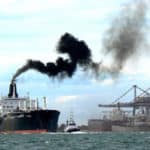Seas of sustainability | Hellenic Shipping News Worldwide

As global industries navigate the complexities of carbon, ammonia, and hydrogen value chains, shipping is engaging as a critical facilitator and enabler of the global green energy revolution. As a transporter of future fuels, shipping is fundamentally supporting the transition of the world’s energy transition.
Speaking at an American Bureau of Shipping (ABS) Sustainability Summit, Christopher J Wiernicki, chairman and CEO of the class society, noted that the recently published ABS Outlook for the coming decades, titled “Beyond the Horizon: View of the Emerging Value Chains,” focuses on three critical value chains that will shape the shipping industry’s trajectory towards 2050: carbon, ammonia, and hydrogen.
At the macro level, the industry must transition to a combination of 70% zero-carbon fuels and 30% carbon-neutral fuels, which requires a substantial increase in renewable energy production and carbon capture capabilities.
On a micro level, Wiernicki pointed to a solution that blends fuel choice, energy efficiency technology, and data optimisation to enhance vessel performance. This integration of factors, he explained, is vital for achieving the required reductions in aggregate fuel consumption. “For shipping CO2 emissions to reach Net Zero, we’re going to need to significantly enhance the potential of energy efficiency improvement technologies to reduce aggregate fuel consumption by 15% on 2023 levels on the existing fleet and on new vessels.”
Carbon capture need
Wiernicki underscored the importance of carbon capture, stating that it should be implemented across the oil-burning fleet, which would lead to a 70% reduction in onboard CO2 emissions. For those unable to adopt carbon capture, the transition to synthetic or zero-carbon biofuels becomes essential as the green fuel timeline progresses.
However, the success of this transition hinges on various assumptions, including the availability and scalability of green methanol and ammonia. Additionally, LNG must evolve to become greener by 2050. The industry must also achieve a consistent 5% annual rate of green fuel adoption year-on-year.
The industry’s transformation must be a carefully orchestrated process to ensure the wellbeing of both the environment and the people involved.
Wiernicki’s insights extended beyond emissions reduction. He highlighted the fierce global competition for green variants of new fuel sources and emphasised that scalability and supply security are paramount. Shipping must demonstrate sufficient demand to justify investments in green methanol production, he said, which may require smaller operating companies to collaborate to achieve industry-scale investment.
“The Outlook also indicates that in the period of 2030, considering the high demand for methanol, smaller players may face challenges to bunker green methanol, if they have been unable to make these scope arrangements,” he said. “This will not be critical initially, as the burning of grey ethanol does achieve a reduction of emissions of up to 10% on a tank-to-wake basis, which obviously can assist in meeting near term emission reduction targets. But as a regulatory focus begins to switch to well-to-wake, green methanol will be required in significant volumes. If adoption of methanol as a fuel continues at the pace it is today then even the use of grey methanol may be constrained by the demand from elsewhere in the chemical industry, suggesting that many ships that are methanol capable will end up burning oil for some time, further underscoring the importance of carbon capture technologies to shipping’s transition.”
Changing landscape
Moving beyond fuels, Wiernicki discussed the profound impact of the global transition on seaborne trade. He anticipates a 40% decline in crude oil trade by 2050, a 43% fall in coal trade, and continued growth in LNG demand until 2040. Simultaneously, iron ore shipping will reduce, container volumes will increase, and other dry bulks will remain robust. These shifts in trade patterns will reshape the composition of the global fleet.
Wiernicki pointed out the challenges in decarbonising different sectors within the maritime industry. Small tankers and bulk carriers have been slower to adopt alternative fuels compared with container ships. The transition may also involve shrinking vessel sizes, but the role of shipping as a facilitator for the transition will remain vital.
As carbon, ammonia, and hydrogen emerge as critical components of the energy landscape, shipping plays a pivotal role in transporting these valuable cargoes. Liquid carbon, ammonia, and hydrogen must be safely and efficiently transported from capture sites to utilisation or storage facilities.
Also speaking at the summit, Emanuele Grimaldi, International Chamber of Shipping chair and president of Grimaldi Euromed SpA, stressed the urgency of a unified approach. He underscored the need to connect all elements of the energy and fuel chain and advocated for a holistic approach to achieving industry goals. Grimaldi added that infrastructure development and seafarer training must occur concurrently to meet the industry’s ambitious timeline.
Panos Koutsourakis, ABS vice president of global sustainability, echoed the challenges facing the maritime industry in meeting International Maritime Organization targets. Speaking at the event, he emphasised the importance of energy efficiency, carbon capture, and carbon-neutral green fuels. Koutsourakis also highlighted the industry’s competition for residual fuel and the need for smaller shipowners to collaborate to secure long-term fuel contracts.
He too held up biofuels as a primary solution for achieving IMO rules compliance, believing that biofuels will play a crucial role in the industry’s transition. Additionally, he stressed the role of governments in enabling the adoption of green hydrogen.
Source: The Baltic Exchange

